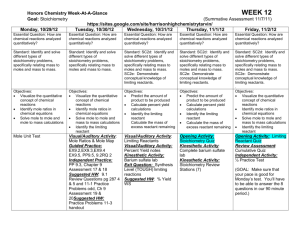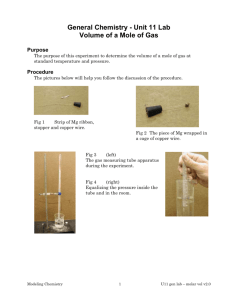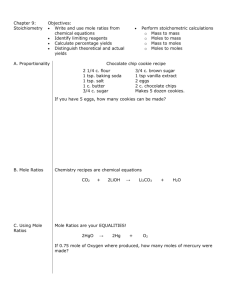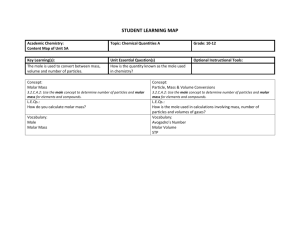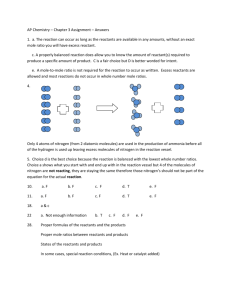Mole Scavenger Hunt - molesandstoichiometry
advertisement
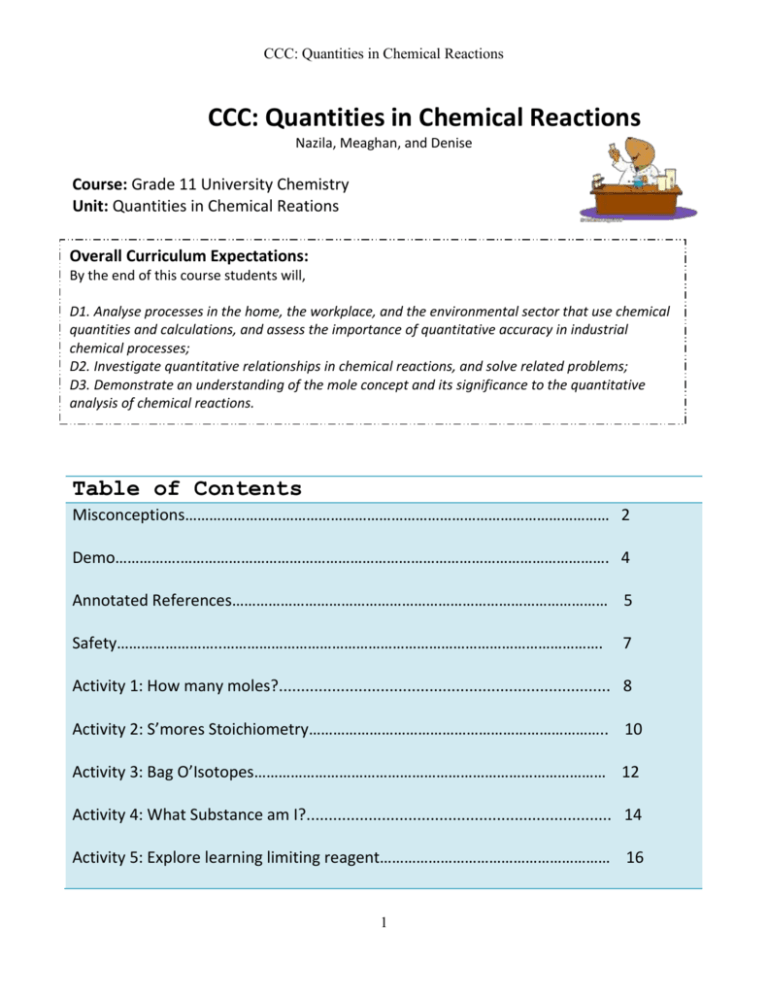
CCC: Quantities in Chemical Reactions CCC: Quantities in Chemical Reactions Nazila, Meaghan, and Denise Course: Grade 11 University Chemistry Unit: Quantities in Chemical Reations Overall Curriculum Expectations: By the end of this course students will, D1. Analyse processes in the home, the workplace, and the environmental sector that use chemical quantities and calculations, and assess the importance of quantitative accuracy in industrial chemical processes; D2. Investigate quantitative relationships in chemical reactions, and solve related problems; D3. Demonstrate an understanding of the mole concept and its significance to the quantitative analysis of chemical reactions. Table of Contents Misconceptions…………………………………………………………………………………………… 2 Demo…………….……………………………………………………………………………………………. 4 Annotated References………………………………………………………………………………… 5 Safety……………………..…………………………………………………………………………………. 7 Activity 1: How many moles?........................................................................... 8 Activity 2: S’mores Stoichiometry……………………………………………………………….. 10 Activity 3: Bag O’Isotopes…………………………………………………………………………… 12 Activity 4: What Substance am I?..................................................................... 14 Activity 5: Explore learning limiting reagent………………………………………………… 16 1 CCC: Quantities in Chemical Reactions Common Misconceptions/Teaching Strategies The Mole: Misconception: A mole is just a number of molecules. Teaching Strategy: Should emphasize that 1 mole is equal to Avogadro’s constant, 6.02 x 1023. It is a unit of measure and can be considered a “counting word” (ie. it is has a number meaning). Can compare different counting words, like a couple (=2) or a dozen (=12), and then the mole (=6.02 x 1023). Like other counting words, the mole can be used to count anything. In chemistry, the mole is a standard number of particles, 6.02 x 1023 molecules, or atoms, or ions, etc. In fact, the mole is an SI Unit for an amount of any substance (Cerveliati et al. 1982). Misconception: If two substances have equal masses, they have the same number of moles. Teaching Strategy: Different hands-on activities should help. Can count out the same number of different candies, like M&M’s and Smarties. By comparing the masses, students will see that equal numbers of things don’t necessarily have equal mass. Also, can show students that equal mass does not mean equal numbers of things by counting how many peanut M&Ms are in a bag (49 g) versus regular chocolate M&Ms (50 g). Chemical Proportions in Compounds: Teaching Strategy: Molecular modelling kits or Lego can be useful in showing the difference between an empirical formula and a molecular formula. You can mass the atoms making up an empirical formula and relate it to the mass of atoms making up different molecular formulas (that are whole number multiples of the original empirical formula). E.g., compare mass of modelling kit / Lego atoms making up the empirical formula CH and the molecular formulas C2H2 and C6H6. Stoichiometry: Misconception: You can change the subscripts in chemical formulas to balance a chemical equation. Teaching Strategy: Review the importance of subscripts in determining what a substance is, and that if subscripts are changed, the substance will change. Remind students that only the coefficients in front of the chemical formula should be changed when balancing equations. Remind students that if there is no coefficient in front of a chemical formula, it is 1. Misconception: The number of moles of reactants must equal the number of moles of products (BouJaoude & Baraket 2000). Teaching Strategy: Make sure that students realize that balanced equations need to satisfy the Law of Conservation of Mass (ie. same number of atoms of each element as reactants and products) NOT number of moles of reactant = number of moles of product. Can get students to balance equations and then calculate the number of moles to prove point. Misconception: To calculate the molar mass of a chemical, you have to add the atomic weights of all the atoms in the chemical formula together, and then multiply/divide it by the coefficient in front of that chemical formula (BouJaoude & Baraket 2000). Teaching Strategy: Molar mass is independent of the amount of a substance in the reaction (always g/mol, NOT g/ 2 mol or g/ 3 mol). E.g. Molar mass of water, H2O, is 18 g/ mol regardless of which 2 CCC: Quantities in Chemical Reactions chemical equation it is in. Therefore only need to look at chemical formula when calculating molar mass. Misconception: The reactant with the smallest number of moles is the limiting reactant. Teaching Strategy: To show students that it isn’t how many atoms/molecules you have of something, but the RATIO of reactants that is important in determining which is the limiting reactant. Hands-on activities can help, such as the S’mores activity from our Resources Workshop. References: Cerveliati, A., A. Montuschi, and D. Perugini. 1982. Investigation of Secondary School Students’ Understanding of the Mole Concept in Italy. Journal of Chemical Education, 59 (10): 852-856. BouJaoude, S. and H. Baraket. 2000. Secondary school students’ difficulties with stoichiometry. School Science Review, 81 (296): 91-97. 3 CCC: Quantities in Chemical Reactions Demo: Introduction to Limiting Reagent Purpose: This simple demo will introduce students to the idea that one of the reactants is usually in short supply, so is the “limiting reagent” for a particular chemical reaction. The two different scenarios in the demo help students understand that the same reactant is not always the “limiting reagent”. You need to consider the ratio of reactants before deciding which one is the limiting factor. Assumed Prior Knowledge: Students will need to have covered the Chemical Reaction Unit in Grade 11. Materials: -candle -matches -large glass beaker or jar Safety Issues: -ensure quick access to a fire extinguisher -tie hair back with an elastic and tuck in loose clothing -make sure match is completely out before disposing in garbage can! Directions: 1) Set up candle, matches, and large beaker on workbench. 2) Ask students if can recall what limiting and excess reagents are. Scenario 1 3) Light candle and place on workbench with open access to the room. Discuss a potential chemical equation for the combustion reaction of the candle with oxygen in the air (can provide chemical equation for wax, but students should be aware that oxygen is a reactant and that carbon dioxide and water are produced- as an extension, can have students balance this equation). [Write on board] C25H52 (Wax) + O2 ➜CO2 + H2O Balanced equation: C25H52 + 38 O2 ➜25 CO2 + 26 H2O 4) Ask students if this reaction will continue forever, or if one of the reactants will run out (candle will run out). Since the candle gets used up first and there is plenty of oxygen left in the atmosphere (we can still breathe!), the candle is the “limiting reagent”. Scenario 2 5) Pose scenario of covering candle with large beaker. How does this change the amount of reactants available to undergo combustion? (Oxygen supply is now limited). Ask students which of 4 CCC: Quantities in Chemical Reactions the reactants will be used up first- how will we be able to tell? (When run out of oxygen, flame will go out and some of the candle will be left over). 6) Cover candle with beaker and observe what happens (candle will go out). Therefore oxygen is now the “limiting reagent”. Summary 7) Bring student attention to the fact that in one case the candle was the limiting reagent, and in the other case oxygen was the limiting reagent- this shows that one particular substance is not always the limiting factor in a chemical reaction. 8) Secondly, bring up the point that you need to look at the ratio of reactants to see how many of each need to interact for the reaction to occur. Can get this information from the balanced chemical equation (ie. need 38 oxygen molecules to react with one molecule of wax in this combustion reaction). Annotated References: Celebrate Mole Day with help from the National Mole Day Foundation! http://www.moleday.org/ This not-for-profit foundation has a website where you can learn this year’s Mole Day theme (“Molar Express”), learn more about Amadeo Avogadro (Mole Day History) and get great suggestions for Mole Day Projects (Mole piñata anyone?). Links to other websites are limited and other parts of website are somewhat commercialized (but you can get a Mole-themed T-shirt if you like!) ExploreLearning: Chemical Reactions Gizmo Collection http://www.explorelearning.com/index.cfm?method=cResource.dspResourcesForCourse&Co urseID=336 Can look at any Gizmo (interactive animation) on this great website for 5 minutes each Gizmo. Can sign up for free 30-day trial for better access. Chemistry section includes great animations, including the animation on limiting reactants in our Resources Workshop. See rest of website for a range of math and science gizmos for all grade levels. Queen’s University Faculty of Education Resources: Stoichiometry http://educ.queensu.ca/~science/main/concept/chem/c11/c11main.htm Great list of different education resources for Stoichiometry, including Concept Development, Demos, Tips, and Labs/Activities. This is definitely worth exploring. Highlights include fun ideas like teaching balancing of equations using Oreo cookies or Lego. The “Comprehensive Stoichiometry Outline” link has a lot of good problems, “Another Stoichiometry Flow Chart” is an excellent graphical organizer,and “Balancing Equations- 3D Demo” is the idea of actually weighing molecule models of reactants and products to “balance” equations. 5 CCC: Quantities in Chemical Reactions Chemistry: Ten Cool Sites http://apps.exploratorium.edu/10cool/index.php?cmd=browse&category=4 Since 1995, this website aims to feature the best Chemistry websites it has found. A newer website it features is “Chalkbored”, which has links to lessons and even powerpoint presentations! Also, a neat website is “What’s that stuff?” which is all about exploring the chemistry behind everyday items. For this unit, check out “Chembalancer” website, which features interactive games to help students review how to balance equations. Chemistry Lecture Notes http://www.chemistrylecturenotes.com This website has straightforward notes in a slide format that would really help students (and teachers) learn or review various topics in chemistry. The “Mole Calculations” lecture notes seemed to provide a good overview of the material. The “Stoichiometry” section may cover more than is needed under the new curriculum for this unit. Mass Spectrometry Interactive Animation http://www.colby.edu/chemistry/OChem/DEMOS/MassSpec.html This interactive but basic animation will allow you to show students each part of the mass spectrometer and illustrates how heavier ions aren’t deflected to the same extent as lighter ions. Need Shockwave program on you computer to see animation. 6 CCC: Quantities in Chemical Reactions Safety Precautions and Tips Chemical reactions are frequently used in this unit to demonstrate principles of limiting and excess, percent yield, as well as acid base titrations to determine mole ratios. The following safety precautions should be taken Procedures 1. Have students identify the chemicals used and their individual safety warnings. Concentrated acids and bases can burn skin and clothes. 2. Use the fume hood when necessary, do not inhale vapours at any time 3. Research proper disposal for each chemical and make it CLEAR to students what they are to do with reaction products and excess chemicals. 4. Be mindful of Bunsen burners and hot plates and the inexperience students in grade 11 may have with such equipment. 5. Post emergency phone numbers by the phone 6. If making use of activities involving food, do not allow students to eat food used for activities. 7. Set up glass disposal as at least some glass breakage is bound to happen! General Tips: - Conduct a simple safety lab prior to assigning content related labs As the teacher, regulate chemicals, clean up, and equipment useage For classrooms which don’t have a separate lab area, make sure that books, bags, and other belongings are far removed from lab benches. 7 CCC: Quantities in Chemical Reactions Activity #1 How many Moles?! Teacher Information Overall Expectations D2. Investigate quantitative relationships in chemical reactions, and solve related problems; D3. Demonstrate an understanding of the mole concept and its significance to the quantitative analysis of chemical reactions. Specific Expectations: Students will… D2.3 solve problems in chemical reactions by performing calculations involving quantities of moles, number of particles, and atomic mass. D3.3 Describe the relationship between avagadro’s number, the mole concept, and the molar mass of any given substance. D3.4 explain the quantitative relationships expressed in a balanced chemical equation using appropriate units of measure (ie. Moles, grams, ions, atoms…) Activity Rationale: Because the Avogadro constant is a huge number students lose connection to the mole as solely a unit measurement. A mole’s magnitude can be more easily understood by visualizing the amount in everyday ordinary items. This activity presents the mole as a tangible and accessible means of expressing a quantity of atoms. Rather than just being able to do the calculations, this activity will help students thoroughly understand the concept and practicality of mole. This activity should also help combat the misconception that moles of different substances have the same mass. Explanation: In this activity students will determine the number of moles of chalk used to draw a self portrait. 1. They will choose a piece of chalk and find the mass using an electronic balance 2. They will draw a self portrait and find the mass after the drawing 3. They will determine how many moles of chalk were used in the drawing. To do this they will need a periodic table to find the molar mass of chalk, CaCO3 (molar mass = 100.09g/mol). 4. Moles of chalk will = mass of chalk used in drawing/ molar mass (100.09g/mol). Activity Extension: This activity can be used as a demonstration or introduction into the Mole Scavenger Hunt. The Mole scavenger hunt should be adapted to your specific students and classroom but may involve such activities as: - drink a can of mountain dew – how many moles of sugar were consumed? - How much space is required to plan a mole of blades of grass? - How many recycling bins are needed to recycle a mole of newspapers? 8 CCC: Quantities in Chemical Reactions Name How many moles? Activity: In this activity you will determine how many moles of chalk it takes to draw a picture of yourself! Make a guess first! How many moles will it take? Instructions: 1. Choose a piece of chalk. Find its mass in grams using the electronic balance. Record the mass in the table provided. 2. On the chalkboard, draw a self portrait. 3. Find the mass of the piece of chalk again and record in the table. Mass of Chalk (g) Before drawing: After drawing: 4. How many grams of chalk were used in the portrait? 5. The chemical composition of chalk is CaCO3, using your periodic table, determine the molar masses of each element. What is the total molar mass of chalk? Ca ___________ C ____________ O3 ____________ Molar mass CaCO3 _______________ 6. Use the formula n = m/M to determine how many moles of chalk were used to draw your self portrait. 9 CCC: Quantities in Chemical Reactions Activity #2 S’MORES STOICHIOMETRY! Teacher information Taking into account the law of conservation of matter, students will explore the principles of stoichiometry by building s’mores. A s’more is a traditional campfire snack made from putting a roasted marshmallow between two graham crackers and adding chocolate chips. Through this activity students will identify and solve stoichiometry problems as well as be introduced to the conceptual principle of limiting reagents. Overall Expectations D2. Investigate quantitative relationships in chemical reactions, and solve related problems; D3. Demonstrate an understanding of the mole concept and its significance to the quantitative analysis of chemical reactions. Specific Expectations: Students will… D2.6 solve problems relating to quantities in chemical reactions by performing calculations involving percentage yield and limiting reagents. D3.3 Explain the difference between empirical and molecular formula of a chemical compound. Activity Rationale: Everyone loves s’mores! This activity simplifies the concept of limiting reagents in chemical reactions helping the student to conceptualize the process before applying it or calculating it in reaction. Teacher Preparation: 1. Materials needed: electronic balance paper plates chocolate chips graham crackers marshmallows 2. For each group in the class, prepare a plate with chocolate chips, marshmallows, and graham crackers in various quantities. Explanation: After deciding on the composition of their s’mores (ie. 2 crackers, 1 marshmallow, 7 chocolate chips) students will discover that they can’t use all their materials to make a perfect amount of s’mores. The ingredient that runs out first will model the limiting reactant. 10 CCC: Quantities in Chemical Reactions NAME: S’MORES STOICHIOMETRY! Activity: Imagine you're on a camping trip and have just made a roaring campfire. You and your friends are about to make s'mores. One of your friends was in charge of the marshmallows and brought an entire bag, you were in charge of the graham crackers and brought a whole box and another friend was in charge of the chocolate but ate most of it on the car ride. Which ingredient will limit the number of s'mores that can be made? For this activity, each s’mores ingredient represents an element: - Marshmallow (M) Graham Cracker (G) Chocolate chips (Cc). The Graham cracker is a diatomic element and is always found in pairs. It should be represented as G 2. Instructions: 1. Decide what elements and how many of each it takes to create a s’more. There is no set “recipe” for a s’more. You decide how you want it put together! 2. What is the empirical formula for your s’more? 3. Write and balance a synthesis equation for the formation of a s’more. 4. Cause the reaction to go to completion by forming as many products as possible. How many s’mores were made? 5. What was the limiting reactant of this experiment? Were there reactants in excess? 11 CCC: Quantities in Chemical Reactions Activity #3 BAG O’ ISOTOPES! Teacher notes Activity Rational: In this activity students will calculate the mass of a made up element (beanium) by averaging the mass of a sample of three different beans (representing isotopes). This activity should be used at the beginning of the quantities and calculations unit as a review of isotopes and introduction into molar calculations. Expectations: Students will… Review their knowledge of isotopes and calculation of atomic mass. This review will help prepare students for using atomic mass to perform mole calculations. Activity Preparation: 1. Materials Three types of beans of visually different sizes Plastic baggie Student hand out 2. In the baggie put a mix of the three different types of beans. There should not be an equal amount of each. Explanation: Atomic mass and thus molar mass represent an average of the percent abundance of isotopes found in nature. Difference in mass is attributed to differing number of neutrons. Each of the three types of beans represents a different isotope with a different atomic mass. Students will count and then find the average mass. (An isotope of sodium) Post activity extension questions: 1. 2. 3. 4. Which Beanium isotope is most abundant in nature? Where would Beanium be on the periodic table? Atomic masses for elements have fluctuated slightly over time. Why might this be? What would the difficulties be in determining the atomic mass of an actual element? 12 CCC: Quantities in Chemical Reactions Name: BAG O’ ISOTOPES! Activity Congratulations!! You have discovered a new element – Beanium! There have been 3 isotopes of this element discovered. Beanium- 4 has an atomic mass of 4amu. Beanium-5 has an atomic mass of 5amu. Beanium-6 has an atomic mass of 6amu. Before Beanium can be added to the periodic table, you must determine its average atomic mass of Instructions: 1. Count and record in the table provided the number of each beanium isotope. 2. Record the masses of each beanium isotope 3. Calculate the average mass of beanium. Isotope Quantity Mass (amu) Total mass (amu) Average mass of Beanium__________ Extension questions: 1. 2. 3. 4. Which Beanium isotope is most abundant in nature? Where would Beanium be on the periodic table? Atomic masses for elements have fluctuated slightly over time. Why might this be? What would the difficulties be in determining the atomic mass of an actual element? 13 CCC: Quantities in Chemical Reactions ACTIVITY # 4 WHAT SUBSTANCE AM I? TEACHER NOTES Students will be given 6 jars each containing one mole of a different mystery substance in each. 4 of the six contain pure elements and 2 are compounds. Given a periodic table and balance, students will have to determine what is in each jar. Overall Expectations D2. Investigate quantitative relationships in chemical reactions, and solve related problems; D3. Demonstrate an understanding of the mole concept and its significance to the quantitative analysis of chemical reactions. Specific Expectations: Students will… D2.1 use appropriate terminology related to quantities in chemical reactions, including, but not limited to: stoichiometry, percentage yield, limiting reagent, mole, and atomic mass D2.3 solve problems related to quantities in chemical reactions by performing calculations involving quantities in moles, number of particles, and atomic mass Activity Rationale: Students will have the opportunity to solidify their understanding of the mole by using masses and a periodic table to determine unknown substances. As a hands on activity, this will ensure that students make the connection between moles and molar mass. Framed as a silly mystery, the hope is that students will engage in this activity and their own sense of curiosity will encourage complete participation and thus realization of the concepts presented. Activity Preparation: The teacher must calculate and then measure out 1 mole of each of the following substances in labeled bottles of exact same mass. - Bottle A = 1 mole of FeS = 87.9 g - Bottle B = 1 mole of NaCl = 58.5 g - Bottle C = 1 mole of S = 32.1 g - Bottle D = 1 mole of N = 58.7 g - Bottle E = 1 mole of Zn = 65.4 g - Bottle F = 1 mole of Fe = 55.9 g Make sure to weigh bottle before hand and provide this mass to students. Explanation: Have Students: 1. Find and record the mass of each bottle and its mystery substance using an electronic balance 2. Use this mass and the periodic table to determine which substance it is 3. Two of the substances are compounds. Determine whether the compounds are NaCl, FeS, or CaCO3. 14 CCC: Quantities in Chemical Reactions Name: WHAT SUBSTANCE AM I? Activity: You are a chef in big trouble! You have an important restaurant reviewer coming to your restaurant tonight but someone has taken off all the labels from your bottles! How will you know which one is the salt you need for cooking and which bottles contain substances the reviewer will probably find hazardous to have in the kitchen?? In front of you are 6 bottles with the label removed. Each contains one mole of an unknown substance. Using only an electronic balance and your periodic table, determine what each substance is. Clues: ** four of the six are elements, 2 are compounds. The compounds are in bottles A and B and are either NaCl, FeS, or CaCO3. ** the mass of each bottle is: 105.19g ** n = m / M Since there is only one mole of each substance, the mass is also the molar mass. Instructions: 1. Find the mass of each bottle with substance. Record the mass in the table provided. The mass of the bottle itself is 105.19g. Use this information to determine the mass of the substance alone. 2. Using the mass of the substance, determine the molar mass 3. Determine which bottles contain elements and which elements they are. 4. Two of the substances are compounds of either NaCl, FeS, or CaCO3. Determine which bottles contain which compounds. Bottle Mass of Bottle + Substan ce (g) Mass of Substance (g) Atomic Mass of substance A (compound) B (compound) C D E F 15 Substance? CCC: Quantities in Chemical Reactions Activity # 5: Explore Learning Gizmo: the limiting Reagent Teacher notes Overall Expectations D2. Investigate quantitative relationships in chemical reactions, and solve related problems; D3. Demonstrate an understanding of the mole concept and its significance to the quantitative analysis of chemical reactions. Specific Expectations: Students will… D2.2 conduct an inquiry to calculate the percentage composition of a compound D2.3 solve problems related to quantities in chemical reactions by performing calculations involving quantities in moles, number of particles, and atomic mass D2.5 calculate the corresponding mass, or quantity in moles or molecules, for any given reactant or product in a balanced chemical equation as well as for any other reactant or product in the chemical reaction About Explorelearning.com: Explore learning is an online database of science and math interactive modules and simulations. These modules, termed “gizmos” are fun and easy to follow; augmenting curriculum concepts. The gizmo featured here allows students to visualize how the limiting reactant can be determined based on the amount of each reactant at the start of the reaction. Registration to explorelearning must be purchased, but every highschool is expected to have an account. A 30 day free trial is available. www.explorelearning.com Activity Rationale: Chemical reaction concepts are often hard to grasp because of the theoretical nature in which particle interactions must be taught. This gizmo models a limiting reaction in a way that students can visualize and easily grasp. In manipulating the quantities of reactants themselves, students should be better able to engage in the concept being taught. Preparation Instructions: 1. Students in pairs log on to explore learning and search gizmos for “limiting reactants”. 2. Together students follow activity and fill out questions on student handout (see following page). Enrichment activity: If some students finish this activity quickly, there is also a stoichiometry gizmo which is more advanced. More advanced students may find this follow up activity useful. 16 CCC: Quantities in Chemical Reactions Name: Limiting Reactants: Explore Learning Gizmo In this online activity you will explore limiting reactants in chemical reactions by choosing the number of reactants and observing the products created and reactants left over. Instructions: 1. Go to www.explorelearning.com, log in and search the gizmo “limiting reactants” 2. In the Gizmo, select the H2 + O2 becomes H2O reaction. Use the sliders to add 2 oxygen molecules and 2 hydrogen molecules. Each sphere represents an atom. - How many water molecules do you think you can make from this combination? 3. Click Play to remove the barrier between the molecules. Observe the reaction on the SIMULATION pane. The numbers of product molecules are shown on the CONTROLS pane. - Was a reaction able to occur? - Which reactant was used up first, hydrogen or oxygen? Which reactant was the limiting reactant? 4. What amounts should the reactants be in order to create a reaction in which there is no excess reactant. 5. Follow the same procedures for the second reaction C + H2 . a. How many molecules will be made from Five C atoms and six H 2 molecules? b. Seven C atoms and three H 2 molecules? c. Four C atoms and eleven H 2 molecules? Try to answer the questions yourself and use the gizmo to check to see if you are correct. 17 CCC: Quantities in Chemical Reactions 18


